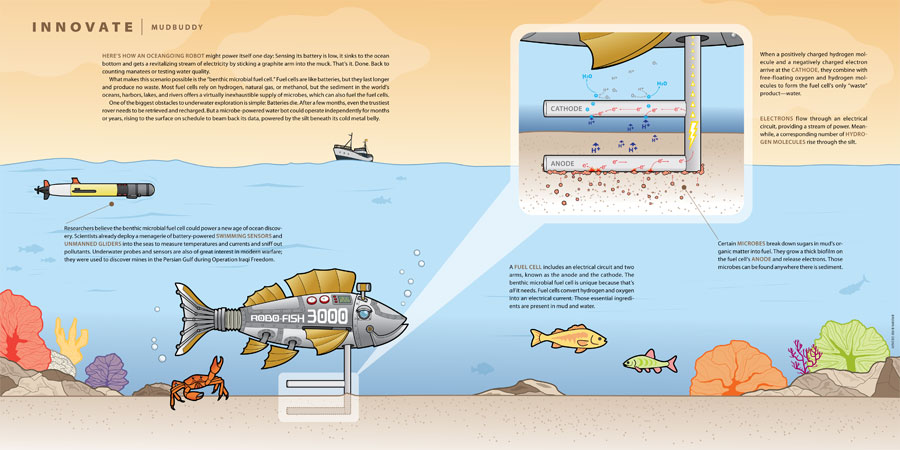sierraclub.org - sierra magazine - may/june 2012 - innovate: mudbuddy
Click on the image below to see the infographic at full size.

Microbe Man
 Dr. Leonard Tender's claim to fame is that he invented the first working microbial fuel cell to be powered by river mud. Two years ago, his device summoned a trickle of electricity from the floor of the Potomac River just outside his Washington, D.C., office for seven months—until winter ice destroyed it.
Dr. Leonard Tender's claim to fame is that he invented the first working microbial fuel cell to be powered by river mud. Two years ago, his device summoned a trickle of electricity from the floor of the Potomac River just outside his Washington, D.C., office for seven months—until winter ice destroyed it.
The power production was minuscule, but that wasn't the point. What mattered was that Tender, an electrochemist at the U.S. Naval Research Laboratory, had produced a steady stream of electricity with nothing more than two pieces of graphite and some wet ooze. "Nature has essentially assembled the fuel cell for you," Tender says.
Since that underwater discovery, many people have requested that he repeat the trick on land. Tender is working with Washington's sewage plant to see if benthic microbial fuel cells could slash the need for electrical power in the treatment of wastewater. The Bill and Melinda Gates Foundation is funding Tender's research into whether Third World latrines could serve as mini-power plants. The U.S. military is wondering whether microbial fuel cells could convert something innocuous—say, a bag of sugar—into a source of energy more power-packed than the battery of a Chevy Volt. Meanwhile, NASA has recruited Tender to design the power supply for a space robot that moves by hopping.
Tender keeps himself grounded by remembering that these technologies will take decades to bear fruit. The 48-year-old also gets some fresh air by bike commuting, sometimes pondering the meaning of it all. "I'm a middle-aged man able to propel myself at 16 or 17 miles per hour on my way to work," he says. "That's like a thousand miles per gallon. There's a lot you can do with a little bit of energy."
Oh, and another thing Tender discovered about those muddy microorganisms: They form strands of highly conductive films, something never before seen in the history of biology—and perhaps the next big step in the miniaturization of electronic devices. —David Ferris
Infographic and illustration by Brown Bird Design